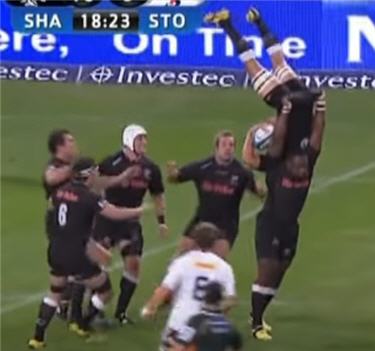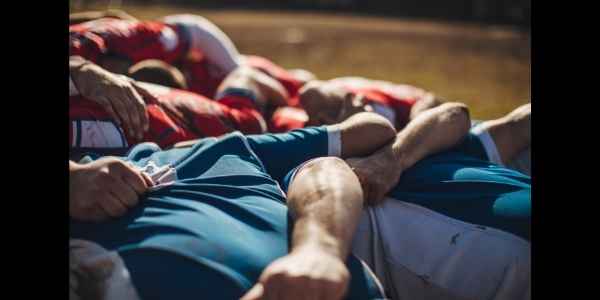Which South African rugby players are the greatest to have played for the Springboks?
Who had the greatest skills and contributed the most to the Springboks and South African rugby? Who made their mark on the wider world?
We’ll start with the seventh greatest player and work our way up to the top. You may not agree with us, but we’ll explain our reasons!
Rules For Our Ratings Of Greatest Springboks
We only selected from players that played since 1980. Why? Because we saw them play!
That rules out legends of the game like Frik du Preez and Jan Ellis.
We also ruled out players who are still playing at the highest level.
Number #7: Tendai “Beast” Mtawarira (Loosehead Prop)
“Beast” is one of two loosehead props on our list of greatest South African players.
Tendai Mtawarira earned his nickname of Beast from his childhood days. It certainly stuck!
Matawrira played 117 times for South Africa from 2008 to 2019.
If you watch Springboks footage on YouTube, listen for a low-register rumbling roar from the crowd when he gets the ball. The crowd is shouting a prolonged “Beeeast”.
Key skills
Mtawarira set a new standard for dynamic props who rampage in open field. His pace was phenomenal for a front row.
He was relatively short at 1.88m or five foot nine. But he combined that size with extraordinary strength that let him make dominant collisions.
He was so strong that he could execute a one-man lift for a lock to catch the kick-off. This went wrong on one occasion and the lifted player toppled backward.
Beast managed to hold and steady the player over his head with an iron grip on his shorts.

Scrummaging and achievements
Two matches stand out for some of the most dominant scrummaging that we’ve ever seen.
The first was the opening test from the British & Irish Lions tour to South Africa in 2009. Beast simply demolished Phil Vickery, the English tighthead.
The penalties kept accruing for the Springboks until Vickery was hauled ashore.
The second match was even more important. The Springboks were up against England in the final of the 2019 World Cup.
Mtawarira did a number on Dan Cole, the English tighthead. This was a vital contribution to the Springboks becoming World Champions.
Number #6: Francois Pienaar (Flanker)
You may be thinking that Francois Pienaar is a little low on our list of greatest Springboks.
But the reason is clear if you look at how we rank the greatest flankers in world rugby. Pienaar sneaks in at number ten. There’s another South African above him.
We simply don’t think that this outstanding captain had the highest flanker skillset.
He also had a very short international career. He won 29 caps over a four-year span from 1993 to 1996.
But Pienaar combined an extraordinary level of self-belief with a calm intelligence. And above all, he had the ability to share or transfer those qualities to his teammates.
His impact on his country and on the wider world puts him on this list.
The run to the 1995 World Cup
When South Africa came out of rugby exile in 1992, they struggled to compete with the top international teams.
The coaches turned for leadership to a player who hadn’t yet been capped. Francois Pienaar was appointed captain and capped in 1993.
The Springboks had a bumpy road to the 1995 World Cup. Nobody outside South Africa thought they could win the tournament.
In the run-up, perhaps some of the players didn’t expect it either. But Francois Pienaar believed they could be champions and he instilled this belief in the squad.
Leadership and achievement
Francois Pienaar ensured that winning a World Cup final actually transcended rugby and became an iconic moment in world history.
Nelson Mandela spoke about proudly handing the cup to the Springbok captain.
“It was under Francois Pienaar’s inspiring leadership that rugby became the pride of the entire county. Francois brought the nation together.”
Nelson Mandela

Number #5: Victor Matfield (Lock)
Victor Matfield is the greatest lineout practitioner that we’ve ever seen.
His athletic leap was a fearsome sight to opposing fans. He stole opposition throws with astonishing frequency.
Matfield destroyed the opposition lineouts throughout South Africa’s march through the 2007 World Cup.
When the Springboks lifted the cup, Matfield was awarded the overall best player in the tournament.
Matfield actually retired from rugby after the Springbok disappointment in the 2011 World Cup. But he returned two years later at the age of 37.
His memorable comeback wins included downing the All Blacks at Ellis Park.
Number #4: Joost Van Der Westhuizen (Scrumhalf)
We are used to scrumhalves being the smallest players on the field. Van Der Westhuizen broke that mold.
Joost stood six foot two inches tall and had a strong frame. He was as large and tough as a flanker.
But he also had great acceleration. His sniping from the back of scrums for tries was unparalleled. He scored 38 tries in 89 caps, which is an outstanding haul for a nine.
Achievements
When South Africa hosted the 1995 World Cup, the All Blacks arrived as favorites. Jonah Lomu lit up the competition and scored four tries in the semi-final against England.
Every neutral expected New Zealand to romp home in the final against the Springboks.
But the Springboks devised a plan. Their goal was to tackle the All Blacks to a standstill. Van der Westhuizen was a key part of this amazing defense.
And aside from his lung-busting cover tackles, he kept his cool to guide the forwards around the park from the base of rucks.
Van der Westhuizen was a key man in the Springboks becoming World Champions.
The rugby world was greatly saddened by his passing after a long debilitating illness.
Number #3: Juan Smith (South Africa)
In our section on Francois Pienaar, we mentioned that we didn’t think he was the greatest South African flanker of the modern era.
Juan Smith is that guy!
Smith won 70 caps for the Springboks in a Test career that spanned from 2003 to 2014.
Key skills
Juan Smith was over 17 stone and stood six feet five. He used his bulk to make dominant tackles that hurled ball carriers backward.
But he was also astonishingly mobile. To add to his speed, he had a ferocious hand-off. Smith was box office when he swatted defenders aside.
This athleticism also extended to his lineout jumping. For a man of his size, he had a fantastic leap.
Achievements
Smith was a pivotal player in South Africa’s successful run to the 2007 World Cup title.
Unfortunately, he was plagued with injuries in older years and took a break from the game in 2012.
He returned to play for Toulon in France in 2013 and was a key part of the Toulon team that won the European Championship that season. The following week, Smith and Toulon won the French domestic title.
Number #2: Os Du Randt (Loosehead Prop)

Os du Randt was the starting loosehead prop when the Springboks became World Champions in 1995. He was only twenty-two.
Unfortunately, the outstanding prop would pick up a series of injuries over the next few years. This kept him out of the game for several seasons. That included missing out on the 203 World Cup.
Du Randt decided to retire at the age of 28 due to being unable to recover.
Two years later, Rassie Erasmus was coaching the Cheetahs and persuaded du Randt to play for the club.
Os put in some dominant performances that caught the eye of Jake White, coach of the Springboks.
When White brought du Randt into the international squad, there were plenty of media commentators who complained that the prop was past it.
That didn’t deter the Springbok fans from roaring “Os, Os” from the stands.
There are few players whose careers spanned two world cup wins with a break in between. John Eales of Australia is a name that comes to mind. Du Randt is another.
The legendary loosehead played all eighty minutes in the final of the 2007 World Cup when South Africa beat England.
The Greatest: Brian Habana (Winger)

We found it very difficult to pick one of our top four greatest South African players as the overall winner.
We considered mastery of the position, overall skills, and major achievements.
But we also considered their impact outside of South African rugby. Which of these players is instantly recognizable across the rugby world?
Brian Habana ticks all the boxes. And he ticks them very fast! He probably intercepted your pen to do so.
The road to legendary status
Brian Habana was capped for the Springboks in 2004. The 21-year-old came onto the field as a sub against England and scored a try.
He scored a total of 67 in 124 caps, which is an outstanding haul.
The young winger lit up the Tri-nations in 2007. He matched the New Zealand stalwarts, Dougie Howlett and Joe Rokocoko, as a joint top try-scorer in the competition.
That year, he was a sensation in the 2007 World Cup. By scoring two tries against Argentina in the semi-final, he matched Jonah Lomu’s record for tries in a single World Cup.
Habana was a master of interceptions and could kill teams by scoring against the run of play. In the semi-final, the Pumas were close to the Springbok try line. Habana intercepted and ran the length of the field to score for his team.
World Rugby named him Player Of The Year.
European exploits
South African fans got to see Habana tear it up for the Bulls and the Stormers.
European fans got the privilege of seeing him burn bright in the French and European tournaments. Habana joined Toulon in 2013 where he played alongside Juan Smith.
Habana’s tries were pivotal to the French club winning the Top 14 and two European Championships.